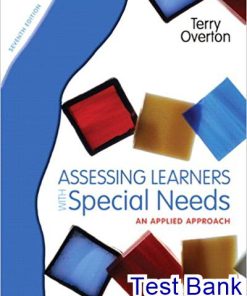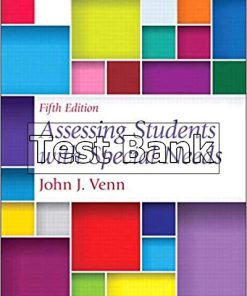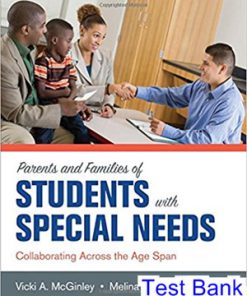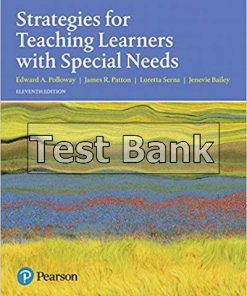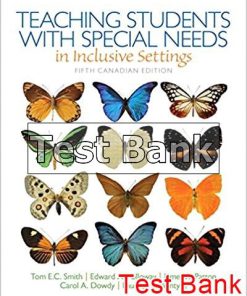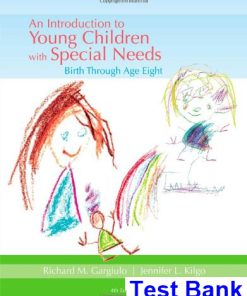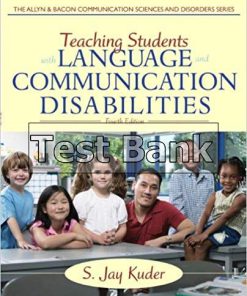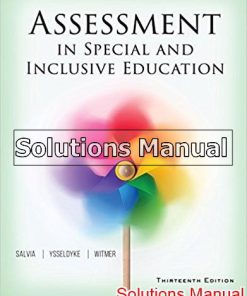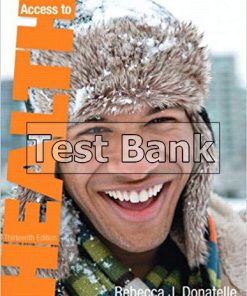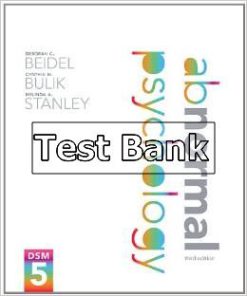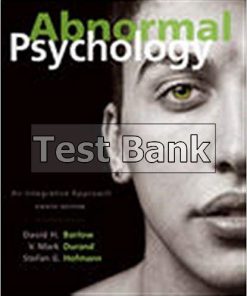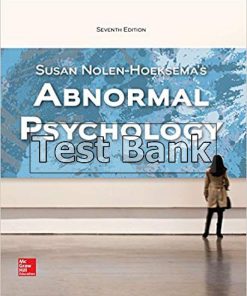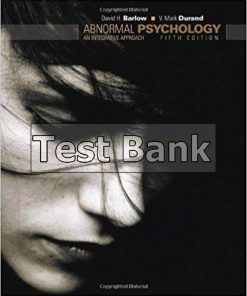Teaching Students With Special Needs in Inclusive Classrooms 1st Edition Bryant Test Bank
$50.00 Original price was: $50.00.$26.50Current price is: $26.50.
Teaching Students With Special Needs in Inclusive Classrooms 1st Edition Bryant Test Bank.
This is completed downloadable of Teaching Students With Special Needs in Inclusive Classrooms 1st Edition Bryant Test Bank
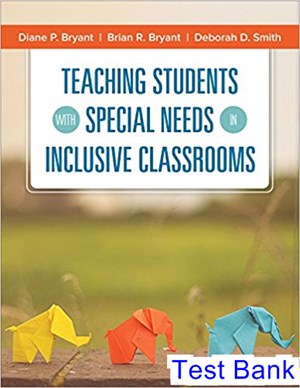
Product Details:
- ISBN-10 : 1483319253
- ISBN-13 : 9781483319254
- Author: Diane Pedrotty Bryant (Author), Deborah Deutsch Smith (Author), Brian R. Bryant (Author)
Equip and empower today’s classroom teachers to ADAPT to the needs of all of their students. Using the research-validated ADAPT framework, Teaching Students with Special Needs in Inclusive Classrooms helps future teachers determine how, when, and with whom to use proven academic and behavioral interventions to obtain the best outcomes for students with disabilities. Through clear language and practical examples, authors Diane P. Bryant, Brian R. Bryant, and Deborah D. Smith show how to create truly inclusive classrooms through evidence-based practices and hands-on strategies. This book will provide the skills and inspiration that teachers need to make a positive difference in the educational lives of struggling learners. The text is written to meet the needs of those majoring in general education, special education, and blended teacher education programs.
Table of Content:
Part I: Foundations of Inclusive Education
Chapter 1: Inclusive Teaching as Responsive Education What is the ADAPT framework and how do I use it? What is a disability? What are some reasons for disabilities? Who are students with disabilities? What are the origins of special education? What laws and court decisions protect students with disabilities? What is special education? What is inclusive education?
Chapter 2: Understanding Learners with Special Needs: High Incidence Disabilities or Conditions Who are students with special needs? Who are students with disabilities? How are disabilities organized for special education? Who are students with learning disabilities? Who are students with speech or language impairments? Who are students with attention deficit hyperactivity disorder? Who are students with intellectual and developmental disabilities? Who are students with emotional or behavioral disorders?
Chapter 3: Understanding Learners with Special Needs: Low Incidence Disabilities or Conditions Who Are Students with Low Incidence Conditions? Who Are Students with Health Impairments or Special Health Care Needs? Who Are Students with Autism Spectrum Disorders? Who Are Students with Multiple-Severe Disabilities? Who Are Students with Developmental Delay? Who Are Students with Physical Disabilities? Who Are Students Who Are Deaf and Hard of Hearing? Who Are Students with Visual Disabilities? Who Are Students with Traumatic Brain Injury? Who Are Students with Deafblindness?
Chapter 4: Other Students with Special Learning Needs Who are the students protected by Section 504? How can we meet the needs of all students in a culturally and linguistically diverse classroom? Who are students at risk? Who are students with gifts and talents?
Part II: Planning for Exceptional Learners
Chapter 5: Developing Collaborative Partnerships What are the characteristics of collaboration? What are critical prerequisite skills for effective collaboration? How can professionals work together collaboratively? Working Together: An example of the collaboration-consultation process Working Together: Co-teaching How can professionals collaborate with paraprofessionals? How can professionals collaborate with families?
Chapter 6: Delivery of Special Services Through Individualized Plans What is response to intervention? What is the evaluation and identification process? What plans guarantee students with disabilities an appropriate education? When and how are individualized plans evaluated? What does IDEA ’04 require during the IEP process? Who are the members of the IEP team? How do IEP teams meet the needs of students with disabilities? Working Together
Chapter 7: Promoting Access to the Curriculum What is Universal Design for Learning? What is the ADAPT Framework What Instructional Practices Help Students Access and Master the Curriculum? What Are Some Effective Instructional Grouping Practices? How Can Instructional Materials Be Adapted? What Are Some Effective Homework Practices? How Can Assistive Technology Help Students Access the Curriculum?
Chapter 8: Assessing Students with Special Needs Why Do We Assess Students? How Do We Assess Students with Special Needs? How Do We Adapt and Modify Assessments for Students with Special Needs?
Part III: Adaptations to Meet Individual Learner Needs
Chapter 9: Promoting Positive Behavior and Facilitating Social Skills What Practices Can I Use to Foster Positive Relationships with My Students? How Can I Communicate Effectively with Students? What Are Effective Classroom Arrangement Practices? What Are the Goals of Misbehavior? What Interventions Are Available for Less Serious Behavior Problems? What Interventions Are Available for More Serious Behavior Problems? How Can I Identify and Assess Problem Behaviors? What Are the Components of Positive Behavioral Supports? What Is Social Competence? What Interventions Can Be Used to Teach Social Skills? How Can I Assess Social Skills? How Can We Promote Safer Schools?
Chapter 10: Teaching Literacy Issues in written communication instruction Reading Writing Integrating reading and writing instruction
Chapter 11: Teaching Mathematics Who Are Students with Mathematics Difficulties? What Is Early Number Development and is it Taught? What Are Arithmetic Combinations and How Do I Teach Them? What Is Place Value and How Do I Teach It? What Is Whole-Number Computation and How Do I Teach It? What Are Rational Numbers and How Are They Taught? Working Together: Collaborating to Support Struggling Students in Algebra What Is Algebra and How Do I Teach It? What Is Problem Solving and How Do I Teach It?
Chapter 12: Facilitating Content-Area Instruction and Study Skills What Difficulties Do Students Demonstrate with Content-Area Instruction? How Can I Teach Content-Area Vocabulary and Concepts? How Can Students Monitor Their Reading Comprehension? How Can Students Benefit from Textbook Instruction? How Can I Facilitate Student Participation? What Difficulties Do Students Demonstrate with Study Skills? How Can Students Learn Time Management Skills? What Are Ways to Facilitate Listening and Notetaking? What Are Ways to Facilitate Memorization and Test Taking?
People Also Search:
teaching students with special needs in inclusive classrooms bryant
teaching students with special needs in inclusive classrooms 1st edition bryant
teaching students with special needs in inclusive classrooms
teaching students with special needs in inclusive classrooms 1st edition
teaching students with special needs in inclusive classrooms 1st edition download scribd
teaching students with special needs in inclusive classrooms 1st edition testbank download pdf
Instant download after Payment is complete
You may also like…
Solutions Manual
Assessing Students with Special Needs 5th Edition Venn Test Bank
Solutions Manual
Strategies for Teaching Learners with Special Needs 11th Edition Polloway Test Bank
Test Bank
Teaching Students with Special Needs in Inclusive Settings Canadian 5th Edition Smith Test Bank
Communication
Teaching Students with Language and Communication Disabilities 4th Edition Kuder Test Bank




